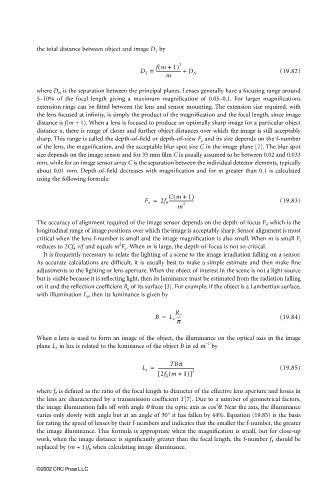Page 506 - The Mechatronics Handbook
P. 506
0066_frame_C19 Page 128 Wednesday, January 9, 2002 5:32 PM
the total distance between object and image D T by
(
---------------------- +
D T = fm + 1) 2 D N (19.82)
m
where D N is the separation between the principal planes. Lenses generally have a focusing range around
5–10% of the focal length giving a maximum magnification of 0.05–0.1. For larger magnifications
extension rings can be fitted between the lens and sensor mounting. The extension size required, with
the lens focused at infinity, is simply the product of the magnification and the focal length, since image
distance is f(m + 1). When a lens is focused to produce an optimally sharp image for a particular object
distance u, there is range of closer and further object distances over which the image is still acceptably
sharp. This range is called the depth-of-field or depth-of-view F o and its size depends on the f-number
of the lens, the magnification, and the acceptable blur spot size C in the image plane [7]. The blur spot
size depends on the image sensor and for 35 mm film C is usually assumed to be between 0.02 and 0.033
mm, while for an image sensor array C is the separation between the individual detector elements, typically
about 0.01 mm. Depth-of-field decreases with magnification and for m greater than 0.1 is calculated
using the following formula:
Cm + 1)
(
F o = 2f # ---------------------- (19.83)
m 2
The accuracy of alignment required of the image sensor depends on the depth-of-focus F i , which is the
longitudinal range of image positions over which the image is acceptably sharp. Sensor alignment is most
critical when the lens f-number is small and the image magnification is also small. When m is small F i
2
reduces to 2Cf # v/f and equals m F o . When m is large, the depth-of-focus is not so critical.
It is frequently necessary to relate the lighting of a scene to the image irradiation falling on a sensor.
As accurate calculations are difficult, it is usually best to make a simple estimate and then make fine
adjustments to the lighting or lens aperture. When the object of interest in the scene is not a light source
but is visible because it is reflecting light, then its luminance must be estimated from the radiation falling
on it and the reflection coefficient R o of its surface [3]. For example, if the object is a Lambertian surface,
with illumination L o , then its luminance is given by
B = R o (19.84)
-----
π
L o
When a lens is used to form an image of the object, the illuminance on the optical axis in the image
−2
plane L S in lux is related to the luminance of the object B in cd m by
TBπ
L s = -------------------------------- (19.85)
(
[ 2f # m + 1)] 2
where f # is defined as the ratio of the focal length to diameter of the effective lens aperture and losses in
the lens are characterized by a transmission coefficient T[7]. Due to a number of geometrical factors,
4
the image illumination falls off with angle θ from the optic axis as cos θ. Near the axis, the illuminance
varies only slowly with angle but at an angle of 30° it has fallen by 44%. Equation (19.85) is the basis
for rating the speed of lenses by their f-numbers and indicates that the smaller the f-number, the greater
the image illuminance. This formula is appropriate when the magnification is small, but for close-up
work, when the image distance is significantly greater than the focal length, the f-number f # should be
replaced by (m + 1)f # when calculating image illuminance.
©2002 CRC Press LLC

